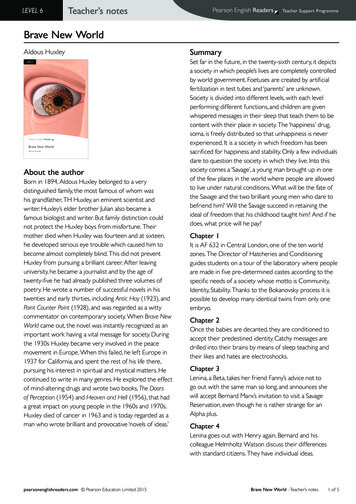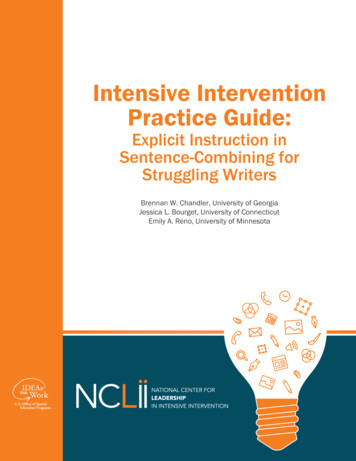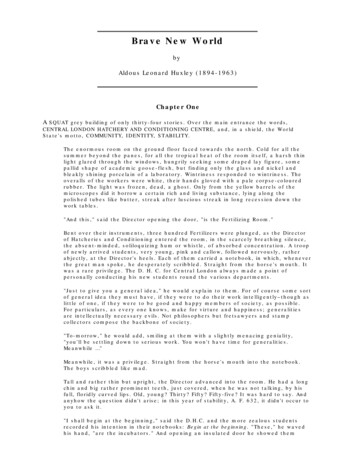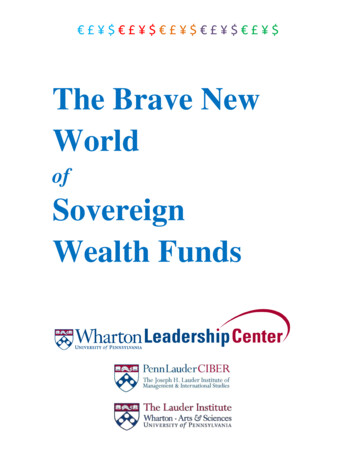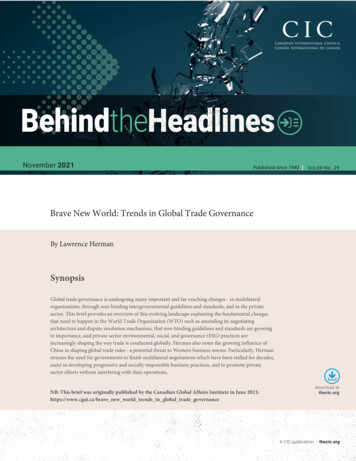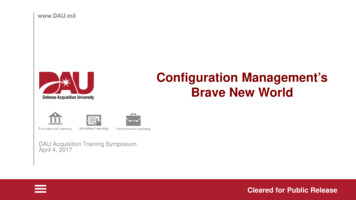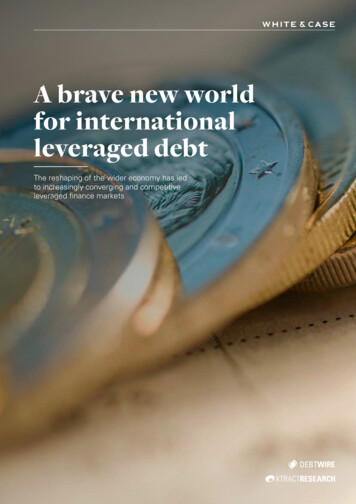
Transcription
lonly, goes hereleveraged debtCover: Stand first. Omnihill oribusapis erum admo dolore de expere pro od quidign ihilicitThereshapingof intma hasnatur,toincreasinglyconvergingcompetitiveaniset latium quoomnis a andquunturibusautleveragedfinancemarketsauditisA brave new world for international leveraged debtI
Innovation andcollaboration are drivingleveraged debt marketsEuropean high yield and leveraged loan markets have adistinctly different feel from 12 months ago. Volumes andvalues notably dropped over 2015, leaving issuers andlenders wondering what to expect in 2016 and beyond.Our report last year, Coming of age, revealed that the European and international marketswere converging in a number of significant ways—across products, markets and investors;across a broader choice of financial instruments; and across legal platforms. We askedthe question: how would this trend, and the related development of the European and internationalfinancial markets, be impacted by a strong, neutral or a declining market?As volumes have retracted from the boom in issuance in 2014, 2015 provides part of the answer, andthe start of 2016 sees a more cautious market due to macroeconomic uncertainty, increased interestrates in the United States, market volatility and compliance reform. These factors have led to someinteresting developments across platforms:Rob MathewsPartner, White & Casein leveraged finance, the emergence of the European Term Loan B as a complementary (orcompetitive) product to high yield bonds has further narrowed the space between bank andbond deals, as well as US banks and European banks;in private equity, while sponsors continue to push for looser deal terms, the markets maybe pausing for breath, with some deal terms tightened in the face of a more discerning andassertive investor base;in emerging markets, where natural resource price volatility and concerns about capitalstructures drove a market retraction in 2015, the high yield and Eurobond markets continue toconverge (particularly in Africa, as the market matures from sovereign and bank issuances tocorporate credits);in restructurings, the tension among US Chapter 11, the UK scheme of arrangement andother voluntary restructuring strategies has become more apparent as the new generation ofinternational bank/bond structures continues to come under pressure; andcredit funds and other one-off investors continue to look for unique opportunities and yield—in some cases, taking advantage of the more reticent public markets to get deals done.Common across each of the platforms are the key themes for 2016—innovation andcollaboration—with all market participants working with their advisers to create structures that aresuitable for both investors and issuers. The boom times are not over for European high yield andleveraged loans in the long term, but the pace, flavour and overall feel will be different from theUS-style model. It is going to be an interesting ride.IIWhite & CaseLee CullinanePartner, White & Case
Leveraged debt:The year in reviewLeveraged debt:The year in reviewEuropean leverageddebt in focusPage 3Page 14A reset for debt in 2015?Evolution andalternatives in the marketPage 7Page 17Eyes on Europe: cov-lite andTerm Loan B risePage 11Innovation is the key tosuccess in 2016Page 18HEADLINESn European loan and bond markets are down from the highs of 2014 n European high yield bonds value marginally up on 2014 totaln Rise of European Term Loan B hints at further market convergenceIf 2014 got pulses racing in thehigh yield debt and leveragedloan markets, 2015 came assomething of a reality check. Inthe first nine months of 2014,combined issuance in these twodebt instruments had alreadysurpassed the entire previous year’stotal by 12 percent. This 201 billionof European high yield debt andleveraged loans pushed on to a finalcount of almost 230 billion by theend of 2014.Fast-forward to the end of 2015and the story was somewhatdifferent. Just 179 billion in highyield debt and leveraged loans hadbeen issued by the year end, withroughly half of that total transactedin the first quarter.Nevertheless, a strong Q4 2015relative to Q4 2014 saw the fullyear value for high yield issuancessurpass that of 2014, but by a merefive percent. This compares withprevious year-on-year increases of21 percent in 2014, 52 percent in2013 and 22 percent in 2012.Leveraged loan issuances fellby 43 percent year on year in 2015,to 73 billion.Slowdown in the globaldebt marketsGeopolitical unrest and an uncertaineconomic outlook in several regionsslowed down a high yield bondmarket that had taken full flight inthe summer of 2014.The drop in issuance was notisolated to Europe. In the far largerUS market, volumes and valuesValue of EU high yield bond and leveraged loan issuance by 1201282,996100,818105,911201420150High Yield Bonds2013Leveraged LoansVolume of EU high yield bond and leveraged loan issuance by year600500400208161300122200100Source: 020High Yield Bonds201320142015Leveraged LoansA brave new world for international leveraged debt3
Value of US high yield bond and leveraged loans issuancesby year1,000,000Value (US 91,097248,172223,33520142015020102011High Yield Bonds20122013Leveraged Loanswere down in 2015, with the secondquarter responsible for the year’speak. A slump in the third quartersaw the lowest issuance of UShigh yield bonds in the last fouryears in terms of value, with barelyUS 223 billion being transacted in2015 compared with US 301 billionat the market’s peak in 2012. It is asimilar story for leveraged loans—2015 saw the US have its worst yearof capital-raising in leveraged loanssince 2011.However, there was still demandfor funding using high yield-stylecovenants and the markets shifted,in part, towards cov-lite Term LoanB (TLB) from instruments such assenior secured TLB. The former grewsubstantially over the last year—particularly in Europe.Vast differences in economic policyhave impacted debt issuance oneither side of the Atlantic, but thereare reasons closer to home for bothof them to explain why numbers havenot kept up the pace in the past18 months. Not all of them arecauses for alarm—and many will beimportant factors in 2016.Volume of US high yield bond and leveraged loans issuancesby 00303417459400200583491561383484350Source: Debtwire02010High Yield Bonds4White & Case20112012Leveraged Loans201320142015There was stilldemand for fundingusing high yield-stylecovenants and themarkets shifted, inpart, towards USTerm Loan B, whichgrew substantiallyover the last year—particularlyin Europe.CASE STUDYThe rise of TLBCabot FinancialCov-lite Term Loan B (TLB), in terms of covenant protection,has many similarities to high yield, though the former hastypically softer call protections than those on the latter.This debt instrument caught on in Europe in 2014 andtook hold in 2015. “Cov-lite” came into fashion fromacross the Atlantic and the issuing community has takennote. As the rest of the bond market slowed, TLBscame into their own, with a threefold uptick in Europeanissuance year on year.However, despite investors’ search for yield, asvolatility increases investors will limit how much riskthey are willing to take. The US 5.6 billion cross-borderloan for tech company Veritas was pulled in November,for example, as prospective investors stayed cool onthe deal due to a variety of reasons. This marked thesecond withdrawal of underwritten loan financing in aweek, coming just after OM Group’s withdrawal of aUS 575 million financing round. “It’s not unheard offor a bond on a best efforts basis to be withdrawn butthe loan underwritten ones less so,” one buy-sider toldDebtwire at the time. “Market volatility is the driverbehind it.”This indicates how quickly the market can change andhow there can be new lines drawn in the sand for thesector as global economics shift.While the numbers show that looser terms becamevery successful in 2015, issuers and their advisers havebeen learning, innovating and talking with investorsdirectly to refine and understand market focus points,helping deals get to market and doing their best to ensureno one loses out if and when financial difficulty strikes.As international M&A heats up and complex corporatestructures become the new normal, White & Casehas helped create a template for sophisticated,multi-subsidiary financings.The team advised Cabot Group in November 2015 ona transaction that amended a 200 million English lawrevolving credit facility agreement (including an accordionand amendments to accommodate Cabot Group’s growthin certain other jurisdictions) and issued 310 million in NewYork law senior secured floating rate notes. The proceedswere partially used to prepay a 90 million acquisition bridgefacility which was entered into in June 2015.Additional sterling-denominated debt was also issued,taking the total existing indebtedness in the form ofnotes—other than the newly issued 310 million floatingrate notes—to 690 million.The deal was certainly innovative as the revolving creditfacility agreement and the senior secured floating ratenotes, along with the additional debt issued, are regulatedby two intercreditor agreements yet secured by the samesecurity package (with different rankings). Additionally,the security package includes, amongst other securitydocuments governed by Luxembourg law or Irish law,two separate English law debentures, each subject to adifferent intercreditor agreement.Following a major acquisition by one of its subsidiariesof the Marlin Financial Group in February 2014, Cabot didnot terminate the existing Marlin intercreditor agreementregulating the debt of the acquired Marlin Financial Groupdue to the existence of 150 million senior secured fixedrate notes issued by a Marlin company. Instead, Cabotamended it to align with its own conditions, meaning theconsolidated group’s financial indebtedness has sincebeen regulated by two intercreditor agreements.This extremely sophisticated deal forged an innovativelegal solution for acquiring companies with complexexisting debt arrangements.A brave new world for international leveraged debt5
A reset for debt in 2015?HEADLINESn Mean European leveraged loan deal size in 2015 was 600 million, compared with 617 million a year earlier n High yield bondissuances and leveraged loan allocations for refinancing have fallen substantially n Europe matures but 2015 is “reality check”for issuersAt the beginning of 2015,it was believed that the highyield bond and leveragedloan markets would continue at thelevels seen in 2014. Issuance hadpeaked and terms were loosening.Indeed, the first quarter startedwell; however, as the midpoint of theyear arrived, it was becoming clearthat 2015 was not going to matchthe previous 12 months for issuancein the US and Europe.In 2014, some 60 percent ofhigh yield bonds and 49 percentof leveraged loans had beenissued in Europe for refinancingpurposes. In 2015, that figuredropped to 46 percent and36 percent, respectively. 46%proceeds of 2015European highyield bonds usedfor refinancing,compared with 60%in 2014Many private equity sponsorslooking to exit were seeing bettervaluations through an IPO thanthrough a secondary sale or debtissuance. European equity marketshave been very strong as a result,and this has cannibalised someof the demand for high yield. Thetraditional tension between aleveraged refinancing, an IPO andan M&A exit shifted in 2015, as theIPO market proved stronger thanin recent years.However, private equity did boostthe market with funding for leveragedbuyouts in 2015, particularly on theloans side. While the percentage ofhigh yield bond proceeds used tofinance these deals grew from fivepercent to nine percent, leveragedloan issuance for leveragedacquisitions over the two yearsgrew from 33 percent for add-onsand leveraged buyouts in 2014 to48 percent for the same in 2015.Loan sizes remain resilientFurther evidence of this growingdepth and strength can be seen inthe size of deals that were transactedsuccessfully in 2015. Despite therelative drop off in issuance, theticket size offered by those comingto market has been resilient.The mean European leveragedloan deal size in 2015 was 600 million compared with 617 million a year earlier. In theEuropean high yield bonds use of proceeds3%Add-on acquisition2%General corporate purposes20%29%LBO financingRefinancingSpin-offSource: Debtwire201460%12%46%20155%Other14%9%A brave new world for international leveraged debt7
London,United KingdomEuropean leveraged loans use of proceeds8%Add-on acquisition5% 2%14%Dividend recapitalization20%General corporate purposes6%LBO ngWorking capital19%Other28%1%3%A reality check for the marketThe European market has increasedin size, strength and attractivenessfor lenders and borrowers alike,but 2015 has served as a realitycheck for some issuers who hadbeen allowing themselves to getcarried away. However, in the 150m118European leveragedloans issued in 2015under EUR 150mEuropean high yield bonds deal size 201570Number of issuers60504030472010Source: Debtwire652624BelowEUR 150m8White & CaseEUR 150m EUR 350mEUR 350m EUR 750mEUR 750m EUR 1.5bnEuropean leveraged loans deal size 2015AboveEUR 1.5bnB-rated sector gets largest dealsCertainly, investors were not justlooking at credit ratings and slidingback up the risk scale. Well-knowncompanies with a market historyIn the Europeanhigh yield market,the average dealsize in 2015 rose to 524 million, faroutstripping the 355 million averagetickets a year earlier.14012010080601188840422040current market, issuers have resettheir expectations for pricing andinvestor appetite. The success storyof 2014 put a different perspectiveon 2015—a year when lenders andinvestors became more cautious.In November, BlackRock, theworld’s largest fund manager, saidthat given the uncertainty around oilprices, it viewed “the downside riskto high yield as too high to justifya larger allocation in [its] strategicportfolio”. Bluebay, one of the largestfixed income boutiques, said in thesame month that investors werewary of how credit instrumentswould react to the first hike bythe US Federal Reserve, whichhappened in December.After robust pre-July markets,macro and industry-specific eventshit the sector. Issuers fell intotwo camps: companies that wereknown to the market, had a strongbackground, who went to themarket with aggressive pricingand had little or no pushback; orcompanies that had no rating, werein an industry that was not doingwell or had no market history. Anyof these three characteristics meantthey had wider pricing and tighterterms and, in some cases, simplydid not get deals done.Number of borrowerswith 12 asking for between 1.5 billion and 750 million.On the high yield bond side,the key range was between 350 million and 750 million,with 65 companies issuing atthat level.European high yield market, theaverage deal size in 2015 roseto 524 million, far outstrippingthe 355 million average ticketsa year earlier. In fact, the averagedeal size in 2011 – 2014 hadbeen within the 340 million to 363 million range.However, breaking thesenumbers down might suggest acouple of outlying deals skewedthe numbers in 2015. By far, thelargest component of leveragedloan issuers aimed to borrow lessthan 150 million in 2015. Six aimedat borrowing more than 1.5 billion,Source: DebtwireSource: Debtwire49%0BelowEUR 150mEUR 150m EUR 350mEUR 350m EUR 750m126EUR 750m EUR 1.5bnAboveEUR 1.5bnA brave new world for international leveraged debt9
European bond issuance by S&P rating, 2015Source: DebtwireRating# IssuesAmount (EUR m)Weighted Average YTMWeighted AverageNet LeverageBB 31%3.92xB 4.86xCCC 50%4.67xwere doing well. With bonds worth 25.6 billion, collective capital raisedby 32 B-rated issuers surpassedthe next largest group by almost 8.2 billion in 2015. Some 23 BBissuers raised 17.4 billion, while23 BB issuers raised 16.1 billion,according to Standard & Poor’s.In fact, there were more dealsin the B and B sector than in theBB- to BB sector put together in2015. At an average 789.9 million,issuers awarded a B by Standard &Poor’s managed to get the largestdeals away—many of which wereoversubscribed, according toReuters data.Investors willing to venture thisfar down the risk scale wererewarded with relatively impressivereturns. In 2015, the weightedaverage yield to maturity on B andB rated issuers were 6.02 percentand 6.04 percent, respectively.10White & CaseCASE STUDYGTECH/IGT PlcInnovation was key to the largest Italian bond issued on internationalcapital markets to date, with White & Case acting as the issuer’sinternational counsel for New York, English and Italian law.The firm represented gaming business GTECH on its issuanceof senior secured notes denominated in three tranches ofUS 3.2 billion and two tranches of 1.55 billion in February 2015.The deal, which helped finance the acquisition of IGT Group bythe issuer, used a cross-border pari passu bond/bank transaction andsupported a complex capital structure. The team employed —andenhanced—the latest technologies in European bond/bank structures.An innovative temporary note structure allowed for the issuanceof notes pre-completion—which would not have been permittedby the existing capital structure—thus allowing timely access tothe market and improved commercial terms.The deal also was the first in Europe to see existing Eurobondnote holders obtain a pre-agreement to enter an intercreditoragreement at completion, as the issuance of new secured notestripped their negative pledge.The deal was one of the few secured “covenant lite” high yieldtransactions completed in Europe, and it proved to be a marketleading precedent for companies temporarily crossing into thesub-investment grade space.Eyes on Europe:Cov-lite and Term Loan B riseHEADLINESn US issuers look to Europe n Cov-lite loans growing in popularity on the continent n US Term Loan B structure has been adoptedacross the other side of the Atlantic n Investors concerned over erosion of covenant protectionThe growth of Europeanmarkets was noticed by USissuers, who have lookedacross the Atlantic to borrow aspricing widened in the US andappetite increased in Europe. In thesecond quarter of 2015, US issuerswere the second-largest groupraising euro-denominated debt,according to Source Ratings.At certain points in 2015, thedifference in margin meant it wascheaper to raise funds in Europethan in the US. Companies thatwere well known to investors or hada good credit rating were able totake advantage. Even with FX costs,in some cases this still proved to becheaper than raising dollars in theUS itself.Europe—at least for the moment—offers better macroeconomicconditions for both issuers andlenders than the US. On the eastof the Atlantic, the EuropeanCentral Bank has launched furtherquantitative easing to flood marketswith liquidity; to the west, thefinancial sector had been anxiouslywaiting for a rate rise for severalmonths and finally got onein December.Liquidity favours Europe for now,and this looks set to endure asthe European Central Bank said itwill extend its quantitative easingprogram until at least March 2017,while its interest rate remains atrecord lows.The right credits are getting dealsdone at the right pricing in Europe,with limited or no flex. This will23%European firstlien cov-lite loansin 2015, comparedwith 15% in 201441%US first lien loansthat were cov-litein 2015, comparedwith 48% in 2014likely continue in early 2016 dueto these underlying fundamentals,whereas the US may struggle. Incurrent market conditions in theUS, as the Veritas deal has shown,even after flex some deals are notgetting sold.Covenant-lite rises in EuropeThis flex has become necessary—in some cases—due to thephenomenon that has sweptthrough European debt markets togreat triumph since last year. Thephrase “covenant-lite”, which haslong been common parlance in theUS market, was increasingly usedby European issuers in 2014.In the last 12 months, it has seeneven more frequent usage andacceptance. However, the majorityof European leveraged loans stillretain a quarterly tested leverageratio for the benefit of both therevolving and term loan lenders.One of the few leveraged loaninstruments that saw an increasein issuance in Europe last year wasthe “covenant-lite Term Loan B”.However, that increase was huge.In 2014, some 6.3 billion wastransacted through ten deals. Thenext year, more than 19.5 billionhad been issued through 48 deals.Greater flexibility has beenafforded to issuers in 2015, asparticipants engage in dialogueto address business needs forborrowers and investment risk forlenders. This has meant companieshave been able to transact usingterms that are more suited to theircircumstances and needs withinacceptable parameters for lenders.Borrowers should now be askingthemselves several questions whendeciding what covenant package willbe negotiated into documentation.These include finding out whetherthere’s a maintenance covenanton the debt, whether they haveamortisation, whether they havebaskets that grow with EBITDA orassets, and whether they have anexcess cash-flow sweep.This is vital, as all these pointshave moved towards the borrowerover recent years. It is now verycommon for a loan in Europe to benon-amortising, with no maintenancecovenant and with flexible baskets.Both parties need to start on thesame page to ensure expectationsare met.Investors cautious over cov-liteAs this part of the market moves tobenefit issuers, investors need to becautious as there are fundamentaldifferences between the US andEuropean jurisdictions—and theyshould be aware of them beforebuying into the cov-lite phenomenon.Cov-lite works in the US becauseof the liquidity and depth of themarket. One of the reasonsinvestors in the US typically donot require a financial covenant isbecause the investment modelsuggests that they should be ableto trade out should the need arise.That is generally not the case inEurope—at least not yet. The marketis growing, however, it is stillA brave new world for international leveraged debt11
reasonably nascent, and investorscannot adopt the same assumptionthat they will be able to exit if theydecide that a credit’s performanceand forecast numbers are not to theirliking anymore.While a move back to non-cov-litemay not be on the cards, investorsare being very selective and morefocused on the same issues theylook at in a bond, such as widerindustry benchmarks and leveragelevels. As the secondary marketdevelops, it will mean more flexibleterms are agreed to as a result ofthe ability to move easily betweenprimary and secondary lenders.But the new kid on the block,which is becoming increasinglyestablished, is the non-bank lender.26,634Senior Secured TLB42,60019,569Covenant-lite TLB6,3317,202Senior SecuredTerm Loan10,729Senior SecuredRevolver4,083Covenant-liteTerm Loan3,94519,38713,4797,0621,687Senior UnsecuredTerm Loan6,2001,669Super 078Senior Secured TLC1,3701,076Second Lien3,100Senior UnsecuredRevolver668Senior Secured Capex/ Acquisition Facility643Covenant-liteSecond Lien556White & Case2148Senior eTerm Loan3810%20%European cov-lite30%40%50%US cov-lite7Senior Secured TLA27Senior Unsecured 5Term Loan910Super Senior Revolver199Covenant-lite Revolver113Senior Secured TLC710Second Lien19321125Covenant-lite 5Second Lien924756,29410,00020,00030,00040,00050,000While a move back to non-cov-litemay not be on the cards yet,investors are being very selectiveand more focused on the sameissues they look at in a bond, suchas wider industry benchmarksand leverage levels.First lien111OtherSource: DebtwireSource: Debtwire12Senior SecuredTerm LoanSenior Secured Capex/ Acquisition Facility752014201410Senior UnsecuredRevolver1,0872015Covenant-lite TLB1,344024106151,184Other201348775First lienFirst lien loans (percentage)64Senior Secured TLBRise of non-bank lendingWhere non-banks are providing thefunding, typically, the debt is notbeing distributed and the originalprovider generally remains as thelender. They will, therefore, agreebespoke packages for the businessbecause they don’t need to sellthe debt on, thereby adjustingthe balance between achieving asolution for credit purposes anddocumenting a transaction thatlooks like all the others.The market is also growing atpace. Non-bank lenders are raisingfunds very regularly, and they aregetting bigger; there is a great dealof appetite for investing moneyin non-bank finance structures.1,699Senior Secured TLAEuropean leveraged loan instrument by volumeSource: XtractEuropean leveraged loan instrument by value2502015204060801001202014A brave new world for international leveraged debt13
European leveraged debt in focusSelected European leveraged loan and high yield bond markets by volumeBeneluxGermanyHigh yield bondsHigh yield bonds24Top five most active sectors—high yield bonds5523 13,7937 12,341 9,943 9,180LoansIcelandScale: 50%Loans27PharmaceuticalsLoans 9,4624 21,404 8,040Chemicals& materials 6,839 930Financial ServicesFranceCEEHigh yield bondsHigh yield bonds153133 13,292 1,321 9,540 5,651 2,594 16,100 9,733Chemicals& materialsLoans2142 3,018 7,294 2,191 6,427Top five most active sectors—leveraged loans6Loans 9,0902118 22,903Automotive 8,539 2,0783216 22,545High yield bonds3014 27,950TMTThe Nordics 3431 9,4172817 12,046 11,172 23,014 7,406TMTPharmaceuticalsUK & IrelandItalyHigh yield bondsHigh yield bonds52Services181740 14,948 17,012LoansHealthcare 12,233 11,742 13,584 8,785 2635 5,910 9,168 5,471 12,292 4,882Loans465224 20,316 11,104 3,464 1,080Sectors with highest number of debut issuersServices4SpainManufacturingHigh yield bonds3149Map legend (overall activity ranking) 4,007 4,050LoansLowest2TMT2Energy2Highest11Source: DebtwireChemicals& materials6 13,420 1,49514White & CaseAll graph legendVolume 2014Value ( m) 2014Volume 2015Value ( m) 2015A brave new world for international leveraged debt15
Evolution andalternatives in the marketWhile fears of another downturn loom, the European financial marketshave innovated, evolved and grown.Following the collapse ofLehman Brothers and theperiod that followed, themarkets have more understandingof the credit risk spectrum. Thisincludes jurisdictional risk, availablerestructuring options and thecomplexity involved in anyenforcement process.Further, restructuring is not theunknown prospect it was pre-crisis,as a generation of issuers, bankersand lawyers have all been throughyears of turmoil—and come outthe other side much wiser. Thereis a larger pool of professionalswho understand what it means toconsider solutions for a debtor orissuer facing a liquidity or covenantcrisis, including what entering into arestructuring process means and thekey issues that are likely to arise.The certainty around relevantrestructuring processes—includingthe English scheme of arrangement—has improved as the body ofprecedent has grown. High yieldAs the marketconsiders the chanceof another downturn,there is an expectationof a wave of high yieldbond restructurings.debt has also been issued in recordvolumes in recent years. Now, asthe market considers the chanceof another downturn, there is anexpectation of a wave of high yieldbond restructurings, and thoughtof the solutions that may follow.Non-traditional finance steps inHowever, many companies arenot even getting as far as needingrestructuring advice, due to anothershift within the industry.There were fewer high yield bondrestructurings in 2015 than somecommentators had forecasted, duein the main to the available liquidityin the market. Further, non-traditionalfinance providers, being largely creditfunds, have stepped in to offer adifferent option to issuers wheretraditional lending institutions havebeen unable to provide additionalfunding or refinancing options.It has become increasinglycommon for issuers to seeknon-traditional financing solutionsin the event of financial difficulty,allowing them to amend terms orto action softer restructuring options.Borrowers often do not care whatform their finance takes. What isimportant is how much money canbe borrowed, what interest ratesare going to be like, what terms aregoing to be attached, and when acovenant might be breached thatputs the borrower in default.These financings, which avoid afull scale restructuring, form part ofa larger move towards a more flexibledebt market on both sides of theAtlantic. The low yield environmentand strong liquidity have also gonesome way to encourage lenders,such as fund managers and largeinstitutional investors, to be a littlemore lenient—as long as the termsare right—as a default is arguably inno one’s interest. However, alternativecapital still has a much higher yieldexpectation—and protection—thantraditional high yield debt.Changing the law on high yieldIn 2014, German car park firm APCOAblazed a trail for a new restructuringsolution when it became the firstcompany to request lender consentto amend the governing law ofits bank debt, in order to createsufficient connection to the UKto use a scheme of arrangement.Since this decision, severalcompanies with high yield debt andno immediately apparent connectionto the UK, including DTEK (aUkrainian power company), haverequested holders agree to changethe governing law of their high yieldbonds from New York to Englishlaw, so that the company can u
A brave new world for international leveraged debt 3 I f 2014 got pulses racing in the high yield debt and leveraged loan markets, 2015 came as something of a reality check. In the first nine months of 2014, combined issuance in these two debt instruments had already surpassed the enti
